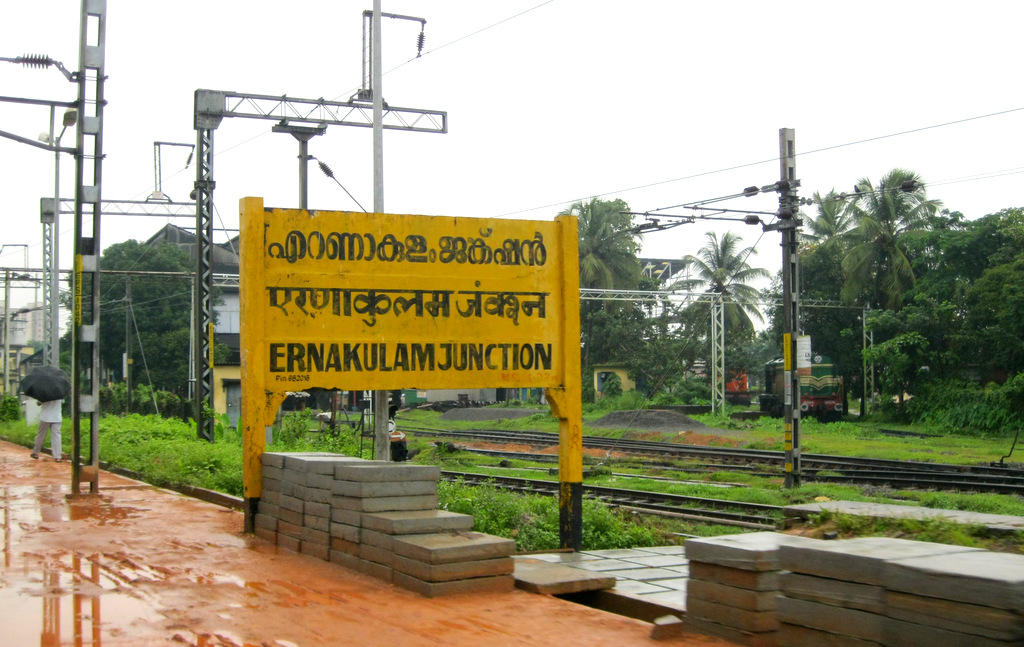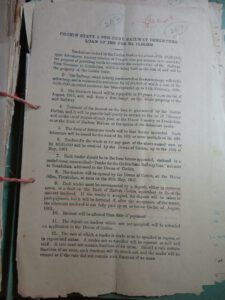The ruling CPI(M) has been accused of being subservient to the descendants of the the former princely state of Cochin.

The Kochi Corporation has passed a resolution to rename the Ernakulam Junction Railway Station as Rajarshi Rama Varma. (Indiarailinfo.com)
The bullock cart was waiting outside the Shoranur Railway Station in present-day Palakkad as a steam locomotive chugged in, bringing Swami Vivekananda to Kerala from Mysore — now Mysuru — in November 1892.
Days ago, he had met social reformist Dr Padmanabhan Palpu, the chief medical officer of the Mysore state hailing from the Kingdom of Travancore, who briefed the 29-year-old monastic philosopher on the untouchability prevalent in the land down south.
The bullock cart rattled and swayed with Vivekananda on board to Thrissivaperur — or Thrissur — in the Kingdom of Cochin, from where he took a boat farther south. Then a part of the Madras Presidency, the Malabar region that spread over Kasaragod and Palakkad, boasted of a well-maintained rail connectivity.
He waited three days to visit the Sree Kurumba Bagavathi Temple at Kodungallur but was denied entry, making him realise that he had sauntered into a lunatic asylum.
The region south of Shoranur then lacked rail connectivity, and Vivekananda continued his journey through the waterways that meandered through the verdant, sedate landscape.
Hardly 10 years after Vivekandanda’s historic visit, Cochin found a place in British India’s rail network when an approximately 120-km metre gauge took the first train to Ernakulam.
In the several decades that followed, the railroad further expanded to Thiruvananthapuram, and then to Kanyakumari, where the parivrajaka sadhu — a wandering monk — Vivekananda meditated for three days from 25 December, 1892, on a rock off the coast, where he reportedly had the “Vision of One India”.
According to the popular narrative, the credit for laying the metre gauge between Shoranur and Kochi goes to Rajarshi Rama Varma, the then-king of the princely state of Cochin.
The present inheritors of the dynasty maintain that the king sold 14 out of the 15 golden caparisons meant for elephants paraded during festivals at Sree Poornathrayesa Temple at Tripunithura, the seat of the kingdom, to raise funds for the ambitious project after the British Presidency had denied financial assistance.
Rama Varma was often seen as a visionary ruler. He also holds the credit for establishing a tramway from Parambikulam forests to Chalakkudy railway station to ferry fine timber to the princely state, where they were converted into furniture and exported even to Britain.
The CPI(M)-ruled Kochi Municipal Corporation unanimously adopted a resolution last week to rename the Ernakulam Junction Railway Station after Rama Varma, considering his contributions to making the rail route a reality.
It was expected that the Union Rail Ministry would positively consider the resolution passed with the active support of the BJP and Congress counsellors.
However, the move has sparked a controversy, with independent observers and various Dalit groups questioning the CPI(M)’s new-found love and subservience to a dynasty and one of its kings with questionable credentials.
They also equated the move with the BJP’s ongoing national agenda of renaming cities, roads, and historical places, often misinterpreting contemporary history.
In Kerala, the then-undivided Communist Party and other Left organisations played a significant role in ending dynastic rule and bringing in progressive and democratic values. In both Cochin and Travancore, Communists always considered the dynasties as the promoters of caste-based discrimination, regressive ideas, and the unequal distribution of wealth.
This is the first time a local body led by the state’s principal Left party, the CPI(M), has come up with an idea to apparently appease the present inheritors of the former princely state, the critics felt.
Considering the social media trolls, shared even by staunch CPI(M) loyalists, the city corporation’s resolution has generated a negative reaction across the state, where people have been critical of former bluebloods and their descendants.

The notification issued by the princely state seeking debenture bonds. From the collection of Cherayi Ramadas. (Supplied)
Noted writer Asokan Cheruvil, general secretary of the CPI(M)-leaning organisation of progressive writers and artists, the Purogamana Kala Sahitya Sangham, criticised the civic body’s move on Facebook. He said the progressive people were duty-bound to fight the authorities’ subservience towards erstwhile dynasties.
“It’s not the communist methodology,” he said of the corporation’s resolution.
Historian Cherayi Ramadas, who had researched the Cochin princely state and rulers, including Rama Varma, quoted archival documents to claim that the king had not sold the golden caparisons to raise funds for the railroad expansion.
“The rail line indeed came up during the period of Rama Varma, but he deserves no credit for its implementation. Even while laying the rail line through the then-British Malabar, the Madras Presidency was keen on extending it from Shoranur to Kochi. Britishers always wanted to develop Kochi as a major port in the south to transport valuables from here to their country, so they pressured the Kochi rulers for a long time,” he said.
“Even the tramway from Parambikulam was established to get the finest timber from the forests to Kochi so that it could be ferried to London, and make furniture to adorn the royal palace there. Even now, many pieces of furniture in high-end London offices trace their origins to Parambikulam. All the infrastructure development initiated at the end of the 19th century and realised at the beginning of the 20th century in the princely state was for the benefit of the Britishers,” Ramadas told South First.
Archives revealed that the Shoranur-Ernakulam railway work was initially estimated to cost ₹50 lakh, and the dynasty found the resources from its exchequer. However, during its implementation, the project required an additional ₹10 lakh. At that time, the then-Cochin Diwan Rajagopalachari urged the king to consider the possibility of utilising the money available with temples under his control.
Rama Varma responded in the negative. Later, a decision was made to find additional funds by issuing debenture bonds. A trust under the senior-most female royal member with huge landholdings and investments provided a loan to complete the project, at an interest rate of five percent.
“The present narrative says the king was forced to sell the caparisons due to a lack of support by the British presidency. However, the South Indian Railway Company, promoted by the British, had implemented the project after finding it mutually beneficial. Kochi always remained a focal point for British business interests in South India,” Ramadas said.
According to Dalit thinker and researcher TS Syam Kumar, fake narratives about Rama Varma started appearing in the media three decades ago.
“How could a few caparisons fetch about ₹10 lakh, a huge amount at that time? They also refer to Rama Varma as a visionary. History shows that he was regressive and reactionary. He justified violence against Dalits and women, and protected the tormentors. The most heinous among them was his defence of those who attacked the women who had entered a temple by covering their breasts,” Kumar said.
Ramadas termed the corporation’s move as insulting to the long legacy of Ernakulam, a region that resisted oppression.
While introducing the resolution, Kochi Mayor M Anil Kumar cited the erstwhile king’s initiative in making the Shoranur-Cochin railway line a reality. He said the princely state of Cochin began its march towards development only after the inception of the railway line.
Railway documents revealed the construction began in 1899, and the inaugural train of the Cochin State Rail Service reached the city on 16 July, 1902. Anil Kumar told South First that the corporation was not subservient to the former royals, but the contributions of the erstwhile king prompted the civic body to adopt such a resolution.
He said he was unaware of the historical documents disputing the claims of the Cochin princely state.
Those who celebrate the legacy of Rama Varma described him as a man of simplicity. They said the title Rajarshi was conferred on him considering his vast knowledge and frugal style of living.
KP Harikumar of the Ernakulam Old Railway Station Vikasana Samithi (Development Committee) lauded the corporation’s decision, saying it was a realisation of a long-cherished demand of city dwellers.
He also claimed Rama Varma, who ruled Cochin from 1895-1914, was a forward-looking ruler who turned Cochin into one of the most progressive Indian states of the time.
Supporters like Harikumar said the former king’s contributions included large-scale reforms in Revenue and Accounts, the establishment of Sanskrit College at Tripunithura, the introduction of the Village Panchayat Bill, and the Tenants Act, apart from the laying the rail route. They said he abdicated in 1914 after developing an aversion to power and positions.
However, Ramadas countered the argument by citing documents indicating that he abdicated the position following disputes within the royal family. He agreed to step down after the rest of the family members agreed to give him vast amounts of property.
Except for a small statue at the Subhash Bose Park in the heart of the city, Rama Varma has no memorial in Kochi.

Jul 15, 2024

Jul 15, 2024

Jul 10, 2024

Jul 07, 2024

Jul 06, 2024

Jul 05, 2024